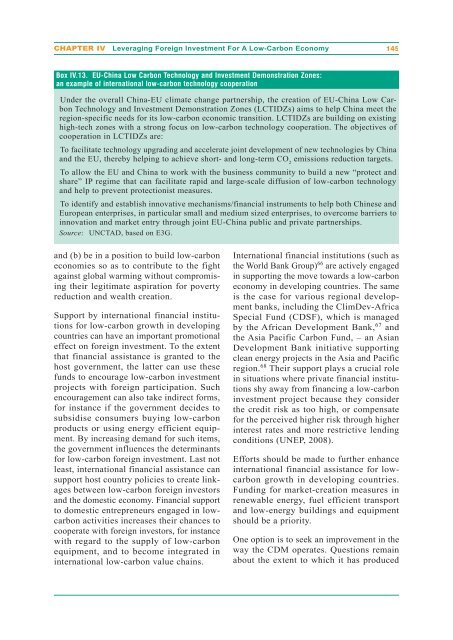UN World Investment Report 2010 - Office of Trade Negotiations
UN World Investment Report 2010 - Office of Trade Negotiations
UN World Investment Report 2010 - Office of Trade Negotiations
You also want an ePaper? Increase the reach of your titles
YUMPU automatically turns print PDFs into web optimized ePapers that Google loves.
CHAPTER IV Leveraging Foreign <strong>Investment</strong> For A Low-Carbon Economy 145<br />
Box IV.13. EU-China Low Carbon Technology and <strong>Investment</strong> Demonstration Zones:<br />
an example <strong>of</strong> international low-carbon technology cooperation<br />
Under the overall China-EU climate change partnership, the creation <strong>of</strong> EU-China Low Carbon<br />
Technology and <strong>Investment</strong> Demonstration Zones (LCTIDZs) aims to help China meet the<br />
region-specific needs for its low-carbon economic transition. LCTIDZs are building on existing<br />
high-tech zones with a strong focus on low-carbon technology cooperation. The objectives <strong>of</strong><br />
cooperation in LCTIDZs are:<br />
To facilitate technology upgrading and accelerate joint development <strong>of</strong> new technologies by China<br />
and the EU, thereby helping to achieve short- and long-term CO 2 emissions reduction targets.<br />
To allow the EU and China to work with the business community to build a new “protect and<br />
share” IP regime that can facilitate rapid and large-scale diffusion <strong>of</strong> low-carbon technology<br />
and help to prevent protectionist measures.<br />
To identify and establish innovative mechanisms/financial instruments to help both Chinese and<br />
European enterprises, in particular small and medium sized enterprises, to overcome barriers to<br />
innovation and market entry through joint EU-China public and private partnerships.<br />
Source: <strong>UN</strong>CTAD, based on E3G.<br />
and (b) be in a position to build low-carbon<br />
economies so as to contribute to the fight<br />
against global warming without compromising<br />
their legitimate aspiration for poverty<br />
reduction and wealth creation.<br />
Support by international financial institutions<br />
for low-carbon growth in developing<br />
countries can have an important promotional<br />
effect on foreign investment. To the extent<br />
that financial assistance is granted to the<br />
host government, the latter can use these<br />
funds to encourage low-carbon investment<br />
projects with foreign participation. Such<br />
encouragement can also take indirect forms,<br />
for instance if the government decides to<br />
subsidise consumers buying low-carbon<br />
products or using energy efficient equipment.<br />
By increasing demand for such items,<br />
the government influences the determinants<br />
for low-carbon foreign investment. Last not<br />
least, international financial assistance can<br />
support host country policies to create linkages<br />
between low-carbon foreign investors<br />
and the domestic economy. Financial support<br />
to domestic entrepreneurs engaged in lowcarbon<br />
activities increases their chances to<br />
cooperate with foreign investors, for instance<br />
with regard to the supply <strong>of</strong> low-carbon<br />
equipment, and to become integrated in<br />
international low-carbon value chains.<br />
International financial institutions (such as<br />
the <strong>World</strong> Bank Group) 66 are actively engaged<br />
in supporting the move towards a low-carbon<br />
economy in developing countries. The same<br />
is the case for various regional development<br />
banks, including the ClimDev-Africa<br />
Special Fund (CDSF), which is managed<br />
by the African Development Bank, 67 and<br />
the Asia Pacific Carbon Fund, – an Asian<br />
Development Bank initiative supporting<br />
clean energy projects in the Asia and Pacific<br />
region. 68 Their support plays a crucial role<br />
in situations where private financial institutions<br />
shy away from financing a low-carbon<br />
investment project because they consider<br />
the credit risk as too high, or compensate<br />
for the perceived higher risk through higher<br />
interest rates and more restrictive lending<br />
conditions (<strong>UN</strong>EP, 2008).<br />
Efforts should be made to further enhance<br />
international financial assistance for lowcarbon<br />
growth in developing countries.<br />
Funding for market-creation measures in<br />
renewable energy, fuel efficient transport<br />
and low-energy buildings and equipment<br />
should be a priority.<br />
One option is to seek an improvement in the<br />
way the CDM operates. Questions remain<br />
about the extent to which it has produced

















